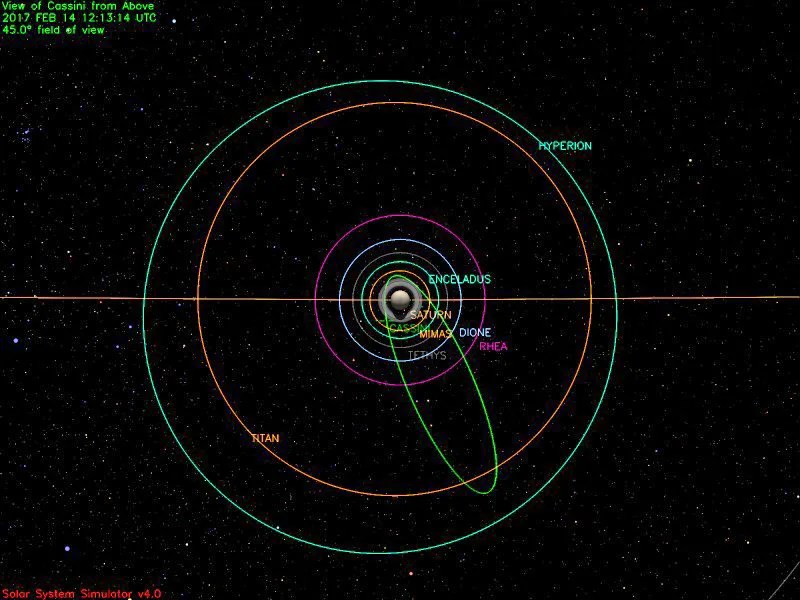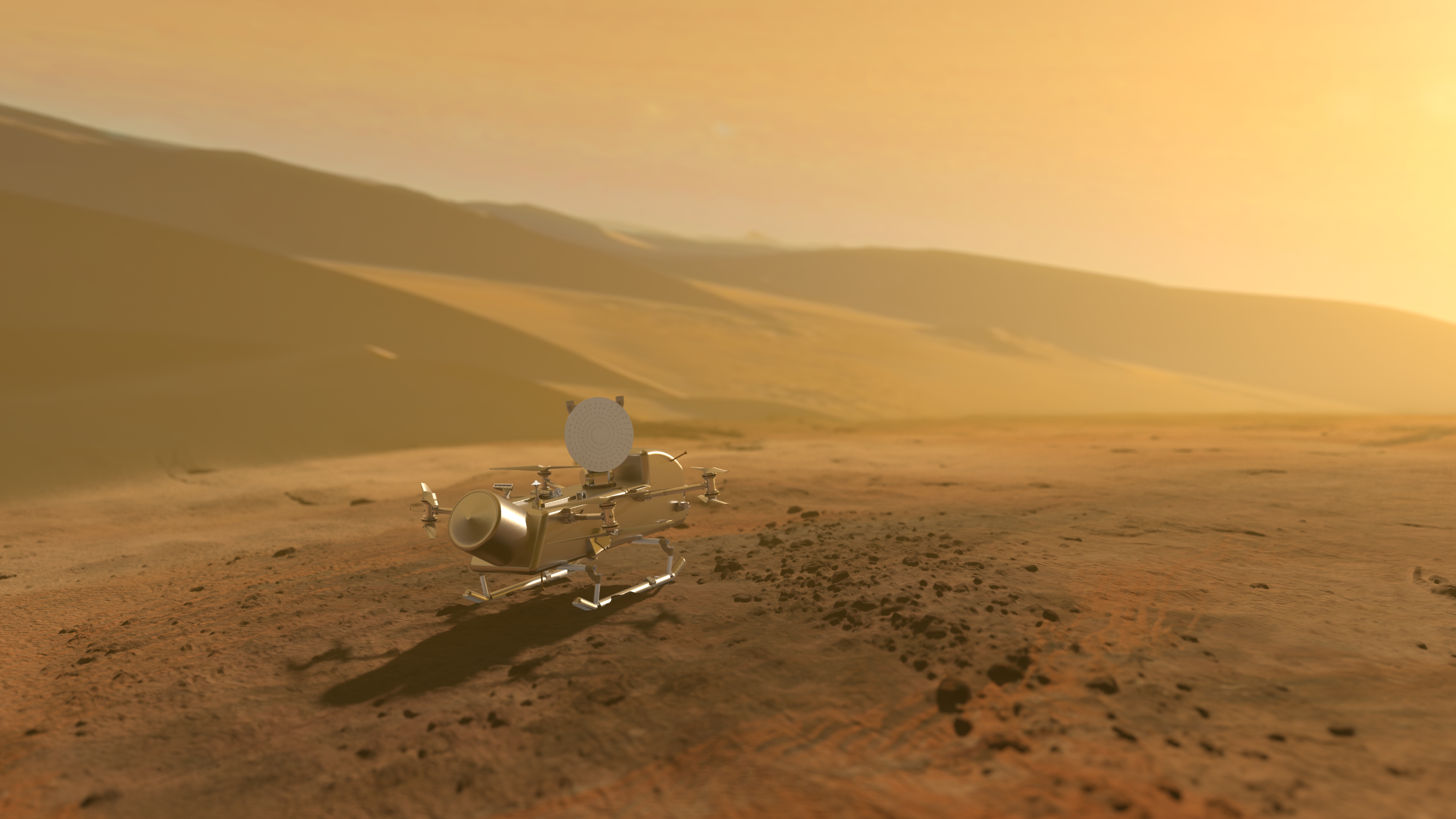7 min read

Cassini the spacecraft had another very busy week in Saturn orbit, gathering unique data and making its 11th plunge, out of 20, through the ring plane. Again, it grazed just outside the planet's narrow, contorted F ring. Cassini, the organization of scientists and engineers and administrators, also had a busy time this week. Preparations were finalized, travels were undertaken, and on Monday, the 71st Project Science Group (PSG) meeting convened near JPL. In parallel with the PSG, Cassini's scientists and engineers still managed to attend to ongoing work, preparing sequences of commands that will control the spacecraft through its final days, coming up this September.
Wednesday, Feb. 8 (DOY 039)
The Visible and Infrared Mapping Spectrometer (VIMS) accounts for two of Cassini's 11 telescopes. Seven of them serve other science instruments, and two are there to provide attitude reference by observing distant stars off to the side. Today the spacecraft slowly adjusted its attitude, by way of its electrically-driven reaction wheels as usual, to keep the VIMS telescopes pointed at a red background star.
Thanks to Cassini's motion in Saturn orbit, bright Alpha Orionis, also known as Betelgeuse, passed behind Saturn's broad A ring and its optically denser B ring. The star "turned around" while it was behind the innermost portion of the B ring. VIMS observed this stellar ring-occultation for five hours, with the Imaging Science Subsystem (ISS) and the Composite Infrared Spectrometer (CIRS) riding along.
Next, ISS spent two hours observing small objects orbiting near Saturn, to refine mathematical models of their orbits. After this, ISS was joined by CIRS, VIMS and the Ultraviolet Imaging Spectrograph (UVIS) for 7.8-hours; these comprise all of Cassini's telescopic, Optical Remote-Sensing (ORS) instruments. The target was Saturn's small moon Enceladus for an important observation while it was back-lit by the Sun, at a distance of around 1 million kilometers. The viewing geometry illustrated here does not simulate Enceladus's plume, but the ORS instruments had a superb view of the material shooting out of the little moon's south polar region, brightly lit in forward-scattered sunlight. Such very high phase angles are ideal for studying the dust-sized particles entrained in the plume.
Thursday, Feb. 9 (DOY 040)
ISS led an 11-hour observation of the more tenuous components of Saturn's rings, which, like Enceladus's plume, contain a significant population of tiny particles. VIMS rode along. The dusty rings were seen at high phase angles, as was Enceladus the day before.
Cassini gave up 30 minutes of its routinely scheduled time with the 70-meter diameter Deep Space Network (DSN) station in Australia today. The New Horizons spacecraft had gone into a safe mode, and that project had requested some extra DSN time from Cassini while they successfully resolved their issue. Recall New Horizons made its highly effective flyby of Pluto and Charon in July 2015, and is en route to a 2019 flyby of the Kuiper Belt object 2014-MU-69. The DSN's two-way communications time with New Horizons was 10 hours 39 minutes. Cassini's by comparison, was 2 hours 56 minutes today.
An invitation to "Share your creations" was featured as "A Valentine: From Cassini with Love" today: /news/12995/a-valentine-from-cassini-with-love .
Friday, Feb. 10 (DOY 041)
Looking towards Saturn's bright crescent limb, ISS spent 2.2 hours working with VIMS and UVIS to study the composition of the planet's high atmosphere. VIMS then led a 9.7-hour mapping observation of Saturn’s northern hemisphere, with CIRS riding along.
While the spacecraft was rotating to point its high-gain antenna dish to Earth for another DSN session, it coasted through apoapsis. This marked the start of Saturn Orbit #261.
Saturday, Feb. 11 (DOY 042)
UVIS performed a collaborative observation with CIRS and VIMS, first staring at Saturn's illuminated northern aurora for six hours, then repeatedly slewing in the same region for another six hours.
Saturday, Feb. 12 (DOY 043)
CIRS spent nearly 21 hours today creating a regional map of the north-polar region of Saturn while the planet rotates twice; VIMS rode along. Results of this will show temperatures in the persistent atmospheric vortex at the pole. CIRS then held onto the reins for another two hours to measure the temperature at the specific latitude and longitude on Saturn where an occultation of the star Gamma Crucis was planned for the following day.
Monday, Feb. 13 (DOY 044)
VIMS spent 2.6 hours mapping Saturn's north pole, with CIRS, ISS and UVIS riding along. VIMS then watched for two hours while the red star Gamma Crucis entered occultation behind the spot in Saturn's atmosphere where CIRS had measured the temperature on the previous day. This observation is one in a series designed to determine the helium-to-hydrogen ratio in Saturn's lower stratosphere.
Next, CIRS took the lead again, with VIMS riding along, to make another regional map of Saturn's north polar region, obtaining more temperature data from the vortex.
Cassini's 71st Project Science Group convened today for a week of meetings in Monrovia, California, not far from JPL. Scientists presented preliminary results from the first ring-grazing orbits, and were wowed by a sneak preview of the “Eyes on Cassini” 3D interactive simulation, which will be making its public-website appearance soon.
Tuesday, Feb. 14 (DOY 045)
Today's plunge through Saturn's ring plane, followed by periapsis passage, was a densely packed observation period. Across the span of only four hours, all of the ORS instruments made observations of Saturn, first from the sunlit side of the planet and rings, then from the dark southern side. Of special interest while very close to Saturn were high-resolution measurements of the vertical distribution of hydrocarbons. Measurements such as these are needed to test and improve models of the photochemicals high in Saturn’s atmosphere. The Magnetospheric and Plasma Science (MAPS) instruments observed as they always do.
In the midst of all the ORS observations, the spacecraft turned to provide the Cosmic Dust Analyzer (CDA) with a favorable view for the two hours centered around ring-plane crossing. CDA directly sampled micron- and sub-micron-size particles in-situ, thereby gathering information about the rings themselves. CDA provides valuable measurements of the grains' chemical composition and other characteristics that are essential to understanding the origin, age, and evolution of Saturn’s rings.
Cassini is constantly falling. Its state of pure free-fall while orbiting Saturn is broken only by small, short-lived bursts from its propulsion system during infrequent Orbit Trim Maneuvers and occasional engineering procedures. This fact inspired a JPL artist to create one final Valentine card, sent from your far-away Saturnian partner: /resources/17603/ .
Another image featured today combines several images. The result brings out the truly extraordinary nature of the neighborhood of Saturn's small moon Daphnis, which is embedded in the outer part of the A ring. The image may be seen here: /resources/17604 .
The DSN communicated with and tracked Cassini on seven occasions this week, using stations at all three of the DSN's locations: Australia, California and Spain. A total of 292 individual commands were uplinked, and about 1,450 megabytes of telemetry data were downlinked and captured at rates as high as 110,601 bits per second.
Wrap up:
Cassini is executing its set of F-ring-grazing orbits of Saturn, with a period of 7.2 days in a plane inclined 63.5 degrees from the planet's equatorial plane. The 20 orbits are nearly identical, with Cassini's nearest point at about 150,000 km, and furthest point at about 1.28 million km from Saturn. Speeds relative to Saturn at those points (periapsis and apoapsis), are close to 76,150 km per hour and 9,000 km/h respectively.
The most recent spacecraft tracking and telemetry data were obtained on Feb. 15 using the 70-meter diameter DSN station at Goldstone, California. The spacecraft continues to be in an excellent state of health with all of its subsystems operating normally except for the instrument issues described at http://saturn.jpl.nasa.gov/anomalies .
The countdown clock in Mission Control shows 213 days until the end of the mission.
In this illustration of Cassini's path up to mid-day Feb. 14, 2017, the spacecraft's orbit looks the same this week, but the spacecraft's position is different.








